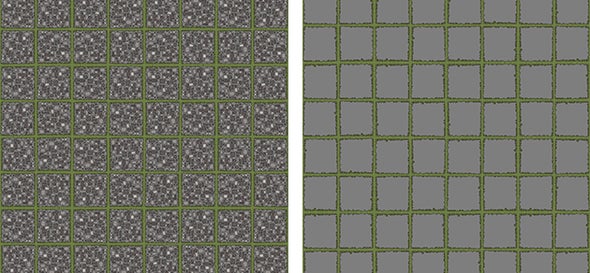On December 2021, Lesha Porche, an illustrator and graphic artist based in Florida, stumbled on an illusion that would become an online viral phenomenon and leave many perceptual experts scratching their heads. Porche’s illustration work often entails drawing maps for tabletop roleplaying games, such as Dungeons & Dragons. This time, she set out to produce a courtyard for the players, and initially noticed nothing amiss. Porche decided on a repeating pattern of tiles edged in grass. She copied, rotated, flipped and randomly pasted tiles out to an 8 x 8 grid. Just as she was ready to use the image she created, she zoomed out to observe the full effect. “I pretty much broke my brain trying to figure out what I’d just made,” she recalls.
In the Warped Grid Illusion unveiled by Porche’s work, a crisscrossing grid over a tile pattern seems to bend and deform in front of the observer’s eyes. In reality, all grid lines are perfectly straight. Moreover, the distortion effect is ever elusive to the onlooker: each and every line that looks warped in one’s visual periphery becomes rectilinear when viewed directly.
“I get headaches from illusions, so I was surprised I had made one so dynamic completely by accident,” says Porche. “My friend Mike Johnson pointed out [that there is] a sort of secret path in the cobble pattern, and this is where the eye keeps ‘jumping,’” she explains. Indeed, the grass-etched grid pattern does not appear to warp randomly, but instead seems to follow the “chains” of pale cobblestones depicted in the tiles. If that is the case, Porche’s creation could be related to Hybrid Image illusions, in which two superimposed images—one containing fine and the other containing coarse visual details, also known as high and low spatial frequencies—result in competing perceptions. The former is best experienced at close range, and the latter from afar (or out of the corner of one’s eye).
In the Warped Grid Illusion, the high spatial frequencies arise from the rectilinear grid, and the low spatial frequencies from the designs formed by cobblestones of like colors. Observed directly, the high spatial frequencies from the grid itself dominate, making its lines look straight. In the visual periphery, the low spatial frequencies from the cobblestone sets take over, warping the grid design with distortions worthy of a Mage’s 7th level illusion spell. A similar phenomenon is thought to explain why Mona Lisa’s smile seems subdued when observed directly, but wider and more obvious when viewed peripherally.




